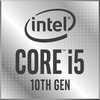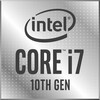Intel Core i5-1030G4 vs Intel Core i7-1060G7 vs Intel Core i7-1060NG7
Intel Core i5-1030G4
► remove from comparison
The Intel Core i5-1030G4 is a power efficient quad-core SoC for laptops and Ultrabooks based on the Ice -Lake-Y generation that was announced in Mai 2019 (Computex). It integrates four Sunnycove processor cores (8 threads thanks to HyperThreading) clocked at 0.7 (base) - 3.5 (single core Turbo) GHz. All four cores can turbo up to 3.2 GHz using Turbo Boost. According to Intel the Sunnycove cores achieve 18% more IPCs (Instructions per Clock).
The biggest improvement for Ice-Lake is the integrated Gen 11 graphics adapter called Iris Plus Graphics. The Core i7-1030G4 integrates the smaller G4 variant with 48 of the 64 CUs clocked at 300 - 1050 MHz. However, in the Y-series the gaming performance will be again depending on the cooling solution and may degrade clearly over time (compared to the Core i5-1035G4 with 15 - 25 Watt e.g.).
Other improvements for Ice Lake are the AI hardware acceleration and the partial integration of Thunderbolt and WiFi 6 in the chip. The integrated DDR4 memory controller supports modules with up to 3200 MHz (and LPDDDR4-3733).
Performance
While we have not tested a single system powered by the 1030G4 as of August 2023, it's safe to expect the chip to be about half as fast as the Core i5-1035G7 (Ice Lake, 4 cores, 8 threads, up to 3.7 GHz), as far as multi-thread benchmark scores are concerned. The 1030G4's low TDP target is set to limit the CPU's real-world Boost clock speeds significantly, leading to underwhelming performance and high DPC latencies.
Power consumption
This Core i5 has a default TDP (also known as the long-term power limit) of 9 W, a value that laptop manufacturers are allowed to increase slightly (12 W being the upper limit) resulting in higher clock speeds and higher performance. The CPU is built with Intel's second-gen 10 nm process for OK, as of mid-2022, energy efficiency.
Intel Core i7-1060G7
► remove from comparison
The Intel Core i7-1060G7 is a power efficient quad-core SoC for laptops and Ultrabooks based on the Ice -Lake-Y generation that was announced in Mai 2019 (Computex). It integrates four Sunnycove processor cores (8 threads thanks to HyperThreading) clocked at 1 (base) - 3.8 (single core Turbo) GHz. All four cores can turbo up to 3.4 GHz using Turbo Boost. According to Intel the Sunnycove cores achieve 18% more IPCs (Instructions per Clock).
Combined with the two additional cores, the previous Y-series dual core processors (Amber Lake-Y) should be always slower. Short burst performance should be excellent, long workloads will depend on the TDP settings and cooling solution in the laptop / tablet.´
The biggest improvement for Ice-Lake is the integrated Gen 11 graphics card called Iris Plus Graphics. The Core i7-1060G7 integrates the biggest G7 variant with 64 CUs clocked at 300 - 1100 MHz. The Iris Plus G7 should be twice as fast as the predecessors and best the AMD Vega 10 GPU in current Ryzen APUs. However, in the Y-series the gaming performance will be again depending on the cooling solution and may degrade clearly over time (compared to the Core i7-1065G7 with 15 - 25 Watt e.g.).
Other improvements for Ice Lake are the AI hardware acceleration and the partial integration of Thunderbolt and Wifi 6 in the chip. The integrated DDR4 memory controller supports modules with up to 3200 MHz (and LPDDDR4 3733).
The Core i7-1060G7 is produced in the new 10nm process at Intel (2nd generation) that should offer a comparable performance to the 7nm process at TSMC. The TDP is specified at 9 Watts and therefore the CPU can be used in thin and light laptops. Intel offers a configurable TDP of up to 12 Watts for the partners resulting in significant performance differences (due to longer periods of Turbo Boost).
Intel Core i7-1060NG7
► remove from comparison
The Intel Core i7-1060NG7 is a power efficient quad-core SoC for laptops and Ultrabooks based on the Ice -Lake-Y generation that was announced in Mai 2019 (Computex). It integrates four Sunnycove processor cores (8 threads thanks to HyperThreading) clocked at 1.2 (base) - 3.8 (single core Turbo) GHz. All four cores can turbo up to 3.4 GHz using Turbo Boost. According to Intel the Sunnycove cores achieve 18% more IPCs (Instructions per Clock).
Compared to the normal Core i7-1060G7, the i7-1060NG7 offers a smaller package size (22 x 16.5 versus 26.5 x 18.5 mm), a higher base clock of 1200 versus 1000 MHz and a 1 Watt higher TDP.
Combined with the two additional cores, the previous Y-series dual core processors (Amber Lake-Y) should be always slower. Short burst performance should be excellent, long workloads will depend on the TDP settings and cooling solution in the laptop / tablet.´
The biggest improvement for Ice-Lake is the integrated Gen 11 graphics card called Iris Plus Graphics. The Core i7-1060NG7 integrates the biggest G7 variant with 64 CUs clocked at 300 - 1100 MHz. The Iris Plus G7 should be twice as fast as the predecessors and best the AMD Vega 10 GPU in current Ryzen APUs. However, in the Y-series the gaming performance will be again depending on the cooling solution and may degrade clearly over time (compared to the Core i7-1065G7 with 15 - 25 Watt e.g.).
Other improvements for Ice Lake are the AI hardware acceleration and the partial integration of Thunderbolt and Wifi 6 in the chip. The integrated DDR4 memory controller supports modules with up to 3200 MHz (and LPDDDR4 3733).
The Core i7-1060NG7 is produced in the new 10nm process at Intel (2nd generation) that should offer a comparable performance to the 7nm process at TSMC. The TDP is specified at 10 Watts and therefore the CPU can be used in thin and light laptops. Intel offers a configurable TDP of up to 12 Watts for the partners resulting in significant performance differences (due to longer periods of Turbo Boost).
| Model | Intel Core i5-1030G4 | Intel Core i7-1060G7 | Intel Core i7-1060NG7 | ||||||||||||||||||||||||||||||||||||||||||||||||
| Series | Intel Ice Lake | Intel Ice Lake | Intel Ice Lake | ||||||||||||||||||||||||||||||||||||||||||||||||
| Codename | Ice Lake-Y | Ice Lake Y | Ice Lake Y | ||||||||||||||||||||||||||||||||||||||||||||||||
| Series: Ice Lake Ice Lake Y |
|
|
| ||||||||||||||||||||||||||||||||||||||||||||||||
| Clock | 700 - 3500 MHz | 1000 - 3800 MHz | 1200 - 3800 MHz | ||||||||||||||||||||||||||||||||||||||||||||||||
| L1 Cache | 192 KB | 192 KB | 192 KB | ||||||||||||||||||||||||||||||||||||||||||||||||
| L2 Cache | 2 MB | 2 MB | 2 MB | ||||||||||||||||||||||||||||||||||||||||||||||||
| L3 Cache | 6 MB | 8 MB | 8 MB | ||||||||||||||||||||||||||||||||||||||||||||||||
| Cores / Threads | 4 / 8 | 4 / 8 | 4 / 8 | ||||||||||||||||||||||||||||||||||||||||||||||||
| TDP | 9 Watt | 9 Watt | 10 Watt | ||||||||||||||||||||||||||||||||||||||||||||||||
| Technology | 10 nm | 10 nm | 10 nm | ||||||||||||||||||||||||||||||||||||||||||||||||
| max. Temp. | 100 °C | ||||||||||||||||||||||||||||||||||||||||||||||||||
| Features | LPDDR4-3733 RAM, PCIe 3, 4 GT/s bus, DL Boost, GNA, MMX, SSE, SSE2, SSE3, SSSE3, SSE4.1, SSE4.2, AVX, AVX2, AVX-512, BMI2, ABM, FMA, ADX, VMX, SMEP, SMAP, EIST, TM1, TM2, HT, Turbo, SST, AES-NI, RDRAND, RDSEED, SHA, SGX | AVX512, DL Boost, Turbo Boost 2.0 | AVX512, DL Boost, Turbo Boost 2.0 | ||||||||||||||||||||||||||||||||||||||||||||||||
| iGPU | Intel Iris Plus Graphics G4 (Ice Lake 48 EU) (300 - 1050 MHz) | Intel Iris Plus Graphics G7 (Ice Lake 64 EU) (300 - 1100 MHz) | Intel Iris Plus Graphics G7 (Ice Lake 64 EU) (300 - 1100 MHz) | ||||||||||||||||||||||||||||||||||||||||||||||||
| Architecture | x86 | x86 | x86 | ||||||||||||||||||||||||||||||||||||||||||||||||
| Announced | |||||||||||||||||||||||||||||||||||||||||||||||||||
| Manufacturer | ark.intel.com |


 Deutsch
Deutsch English
English Español
Español Français
Français Italiano
Italiano Nederlands
Nederlands Polski
Polski Português
Português Русский
Русский Türkçe
Türkçe Svenska
Svenska Chinese
Chinese Magyar
Magyar
